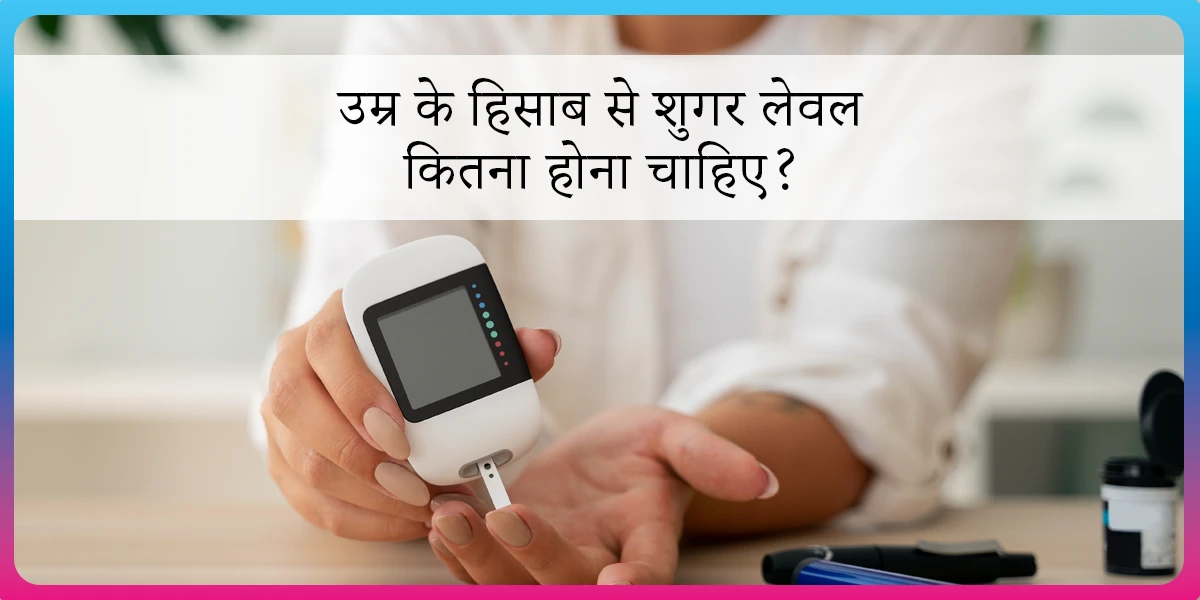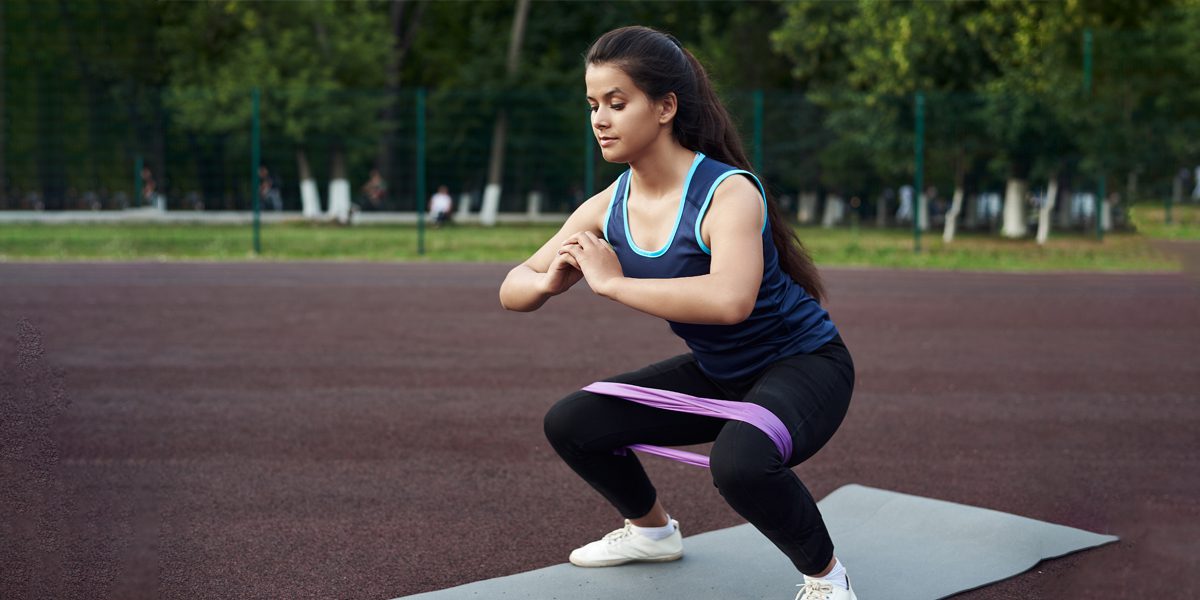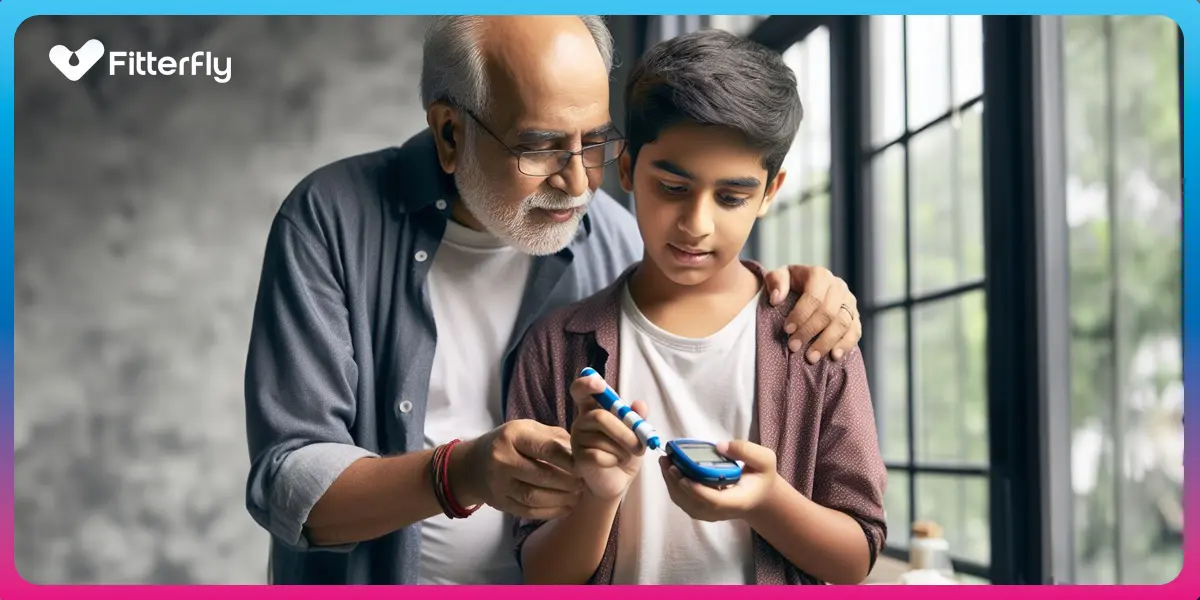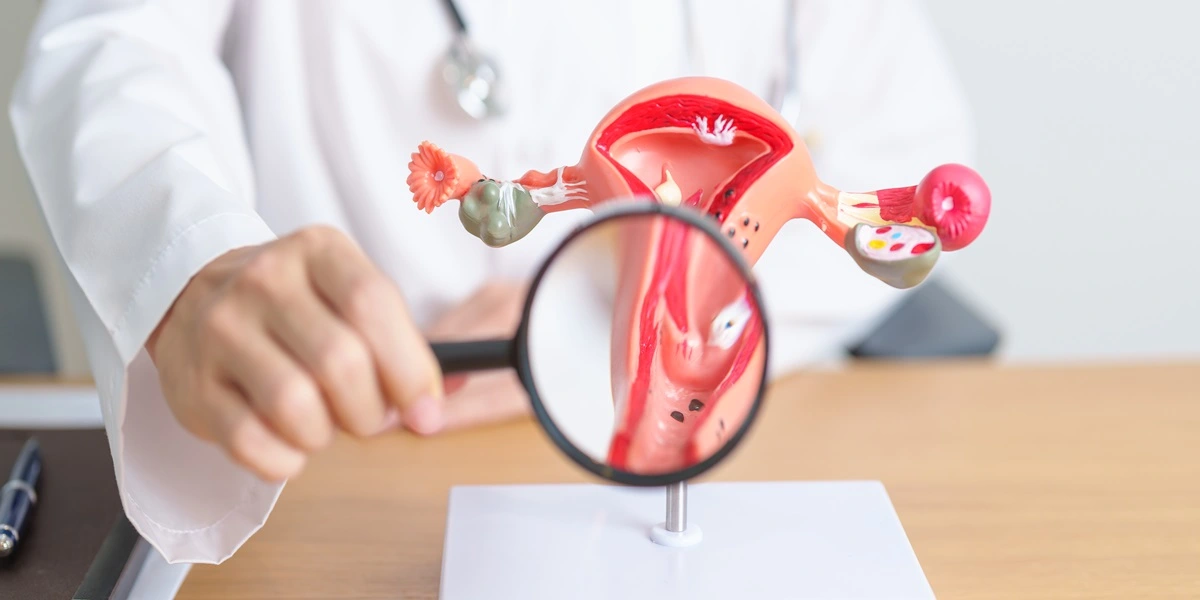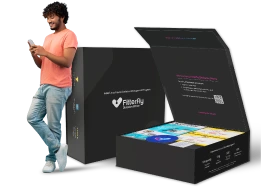Top 4 Tests for Diabetes: What You Need to Know
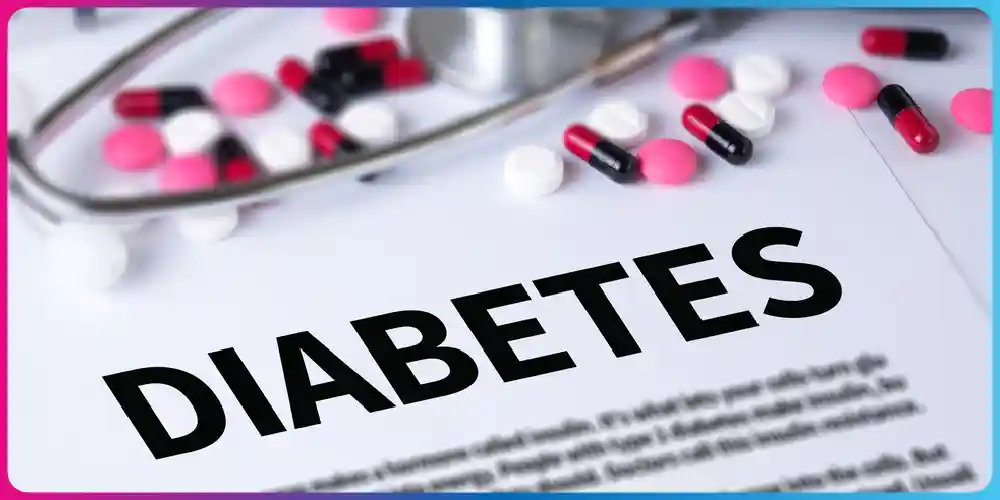
In 2019, 7.7 crore people in India had diabetes. This is expected to rise to over 13.4 crore by 2045.
Alarming, isn’t it? But what is scarier is that a whopping 57% of this data is undiagnosed!
That’s why, regardless of whether you show symptoms or not, understanding diabetes tests is essential. All the more because many people might not even experience symptoms. Therefore, regular testing becomes your only way to find out if you have diabetes or not
In this blog, you’ll learn about the four most common diabetes tests, including those for Type 1, Type 2, and prediabetes, and what they tell you about your health. We will also let you know how you can do these tests independently.
So, let’s get started and by the end of this blog, you’ll know exactly which tests you need to perform to diagnose diabetes!
But, wait! Before we get into the technical details, let’s cover some basics that will help us understand things better:
Who Should Get Tested?
Diabetes doesn’t look at age. It can affect anyone, at any age. If you’re especially 40-45 years old or older, it’s usually a good idea to get tested regularly, even if you feel fine.
But if you’re younger and have conditions like obesity, a family history of diabetes, or high blood pressure, it’s smart to test at an earlier age. Remember, knowing about yourself and your body is important for your health!
Why You Should Test?
Think of these tests as a guide to your body’s health and well-being. They show you how much sugar is in your blood which is not being utilized.
By testing, you can find out if you have diabetes early. This way, you can change your habits and start treatments before things get serious. It’s like being ahead in a game for better health!
What are the Symptoms You need to Check in Diabetes?
Diabetes might sneak into your life without making noise. Some symptoms are being very thirsty, urinating a lot, losing weight without trying, feeling constantly tired, and not being able to see well.
But like we said earlier, sometimes, you might not feel any signs at all. This is why testing is super important – it helps us find out what’s really happening inside.
To know your chances of Diabetes reversal, take the Diabetes Reversal TestDiabetes Reversal
Calculator
What is the Importance of Testing Without Symptoms?
Even if you feel perfectly fine, testing for diabetes is a must. Why? Because diabetes can cause problems even before you feel anything. By finding it early, you can take charge of your health and stop things from worsening later on.
As we go along in this blog, we’ll break down different tests, what they mean, and how they work. From the Haemoglobin A1c (HbA1c) test to the Oral Glucose Tolerance Test (OGTT) and others, you’ll become a diabetes testing pro!
What are the Tests for Prediabetes, Type 1 & Type 2 Diabetes?
1. The Fasting Plasma Glucose Test (FPG)
Take this test as a morning test, when you’re still in your pyajamas! You need to fast for 8-10 hours before the test but don’t worry, you can still drink water. at your dinner early and take this test first thing in the morning and then have your breakfast. The levels indicate as:
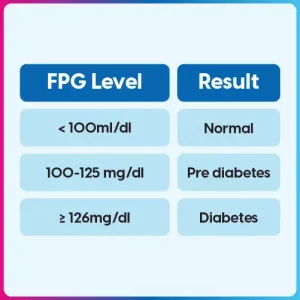
If your blood sugar is 126 mg/dL or higher, it means you have diabetes. If it’s below 100 mg/dL, that’s normal, and if it’s between 100 to 125 mg/dL, it means you might have prediabetes.
2. The Oral Glucose Tolerance Test (OGTT)
To undergo an OGTT, you need to fast overnight. First, your fasting blood is collected, then you drink a glucose-rich, sweet solution. Your blood sugar is tested at intervals of 1 or 2 hours, sometimes extending up to 5 hours.
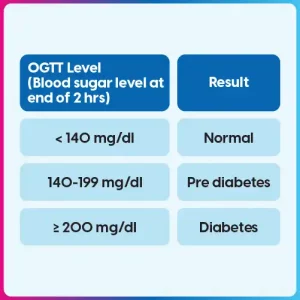

If the result is 200 mg/dL or higher, it means you have diabetes. If it’s below 140 mg/dL, that’s normal, and if it’s between 140 to 199 mg/dL, it means you might have prediabetes.
3. The Haemoglobin A1c (HbA1c) Test
The HbA1c test can see your blood sugar levels for the past 2-3 months! It’s a simple blood test that doesn’t require fasting. The results are shown in percentages as follows:
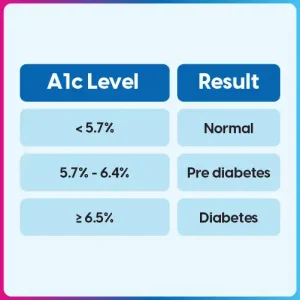

If the number is 6.5% or higher, it means you have diabetes. If it’s below 5.7%, that’s normal, and if it’s between 5.7% to 6.4%, it means you might have prediabetes, like a warning sign for diabetes.
4. The Random Blood Sugar Test
This test is like a quick check to see how much sugar is in your blood at any time of the day. You don’t need to fast for this one, and it’s super simple!
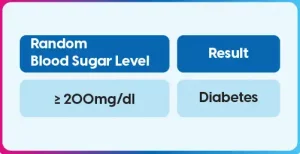

If the result is 200 mg/dL or higher, it means you have diabetes.
Now, let’s talk about the superheroes who made these tests!
What are the Different Diagnosis Criteria for Diabetes Tests?
Now you know the different test criteria, but it is important to check what the health authorities say about these test criteria.
Indian Council of Medical Research (ICMR) Criteria
The Indian Council of Medical Research (ICMR) criteria for the diagnosis of diabetes include the following key points:
| Test | Indicating Diabetes if ↓ |
| Fasting Plasma Glucose (FPG) | 126 mg/dL or higher |
| 2-hour Plasma Glucose (2h PG) during OGTT | 200 mg/dL or higher |
| Random Plasma Glucose (RPG) | 200 mg/dL or higher in individuals with symptoms of hyperglycemia |
| Hemoglobin A1c (HbA1c) | 6.5% or higher |
The American Diabetes Association (ADA) Criteria
Here is a quick summary of the values you need to watch out for which indicates you have diabetes. This is as per the ADA (American Diabetes Association).
| Test | Indicating Diabetes if ↓ |
| HbA1c | 6.5% or higher |
| OGTT (Oral Glucose Tolerance Test) | 200 mg/dL or higher |
| FPG (Fasting Plasma Glucose) | 126 mg/dL or higher |
| Random Blood Sugar | 200 mg/dL or higher |
If your HbA1c is 6.5% or higher, it means you have diabetes. If your OGTT result is 200 mg/dL or higher, it means you have diabetes. If your FPG result is 126 mg/dL or higher, it means you have diabetes. And finally, if your random blood sugar is 200 mg/dL or higher, it means you have diabetes.
World Health Organisation (WHO) Criteria
The World Health Organization (WHO) criteria for the diagnosis of diabetes include the following tests and their test results:
| Test | Indicating Diabetes if ↓ |
| Fasting Plasma Glucose (FPG) | 126 mg/dL or higher |
| 2-hour Plasma Glucose (2h PG) during OGTT | 200 mg/dL or higher |
| Hemoglobin A1c (HbA1c) | 6.5% or higher |
International Expert Committee (IEC) Criteria
The International Expert Committee (IEC) criteria for the diagnosis of diabetes focus primarily on the use of HbA1c as a diagnostic tool. Below is the diagnostic criteria for diabetes:
| Test | Indicating Diabetes if ↓ |
| Hemoglobin A1c (HbA1c) | 6.5% or higher |
How You Can Measure Your Blood Sugar Levels at Home?
Here’s how you can easily test to check for diabetes or your blood sugar levels on your own at home using some of the devices that are easily available in the market.
- Glucometer: It’s a portable device, like your mobile phone, that measures your blood sugar levels when you prick your fingertip and drop a small amount of blood onto it. It’s convenient for daily monitoring of your blood sugar levels at any time.
- Continuous Glucose Monitor (CGM): You must have seen a ₹10 coin, right? This device is similar in size. A CGM continuously tracks your blood sugar levels throughout the day and night. It provides real-time data and alerts for high or low blood sugar levels.
- Ketone Testing: Some home testing kits also include ketone testing, which is important for people with diabetes who are at risk of diabetic ketoacidosis (DKA).
How We At Fitterfly Can Help You?
Testing yourself for diabetes is very important for staying healthy. Many people skip it and only find out they have diabetes when serious problems occur. At Fitterfly, we offer timely tests for diabetes and other health checks as part of our Diabetes Prime program, so you don’t need to go anywhere else.
Our home-based tests include the HbA1c test, fasting blood sugar test, postprandial blood sugar test, lipid profile (cholesterol and triglycerides levels), kidney function test, and liver function test.
We also provide consultation on your test reports with our expert diabetologists, who can guide you on your health progress and help you manage your diabetes effectively.
Reduced diabetes medications in 3 months


6.8%
Happy members
EMI
Guarantee
4.8/5
Diabetes Prime Program
To be certain, we suggest you also speak to our diabetes healthcare team, which has an expert dietician, nutritionist and psychologist to understand the types of tests for diabetes and which one is the best for you!
All this is included in our Fitterfly’s Diabetes Care Program. To learn more about how we can help you manage diabetes, give us a missed call at 08068507599, and we will definitely get back to you.
Remember, a healthy lifestyle and being mindful about your health conditions are essential for everyone, whether or not they have diabetes.
So, let’s keep our health in check!
This blog provides general information for educational and informational purposes only and shouldn't be seen as professional advice.
Frequently Asked Questions
How often should I get tested for diabetes?
If you're at risk of developing diabetes, it's essential to get tested at least twice a year. If you already have a diabetes diagnosis, your healthcare provider will advise you on how often you need to get tested.
Can I still eat before taking a diabetes test?
For some tests, like the HbA1c test and the random blood sugar test, you don't need to fast, so you can eat as usual. But for the FPG and OGTT tests, you need to fast for 8-10 hours, so it's better to take them in the morning after a night's sleep.
What are the normal, prediabetic, and diabetic ranges for test results?
HbA1c: Normal: Below 5.7% Prediabetes: 5.7% - 6.4% Diabetes: 6.5% or higher OGTT: Normal: Below 140 mg/dL Prediabetes: 140 to 199 mg/dL Diabetes: 200 mg/dL or higher FPG: Normal: Below 100 mg/dL Prediabetes: 100 to 125 mg/dL Diabetes: 126 mg/dL or higher Random Blood Sugar: Diabetes: 200 mg/dL or higher
Are there any risks or side effects associated with diabetes testing?
These tests are generally safe and don't have any risks or side effects.
What should I do if my test results indicate diabetes or prediabetes?
If your test results indicate diabetes or prediabetes, don't panic. It's important to work closely with your healthcare provider to create a plan to manage your condition. This may include lifestyle changes, medication, and regular check-ups.
Can diabetes tests give false results?
While diabetes tests are generally accurate, there is a small chance of false results. Factors like timing of testing,medications or certain medical conditions can affect the test outcomes. If you have any doubts about your test results,you can repeat the test or be talk to your healthcare provider before taking these tests.
Which test is best for diabetes?
The best test for diagnosing diabetes is the HbA1c test. It measures your average blood sugar levels over the past 2-3 months and provides a good indication of long-term blood sugar control.
Which blood sugar test is better?
The HbA1c test is generally considered better for diagnosing and monitoring diabetes. However, fasting blood sugar (FBS) and postprandial (PP) blood sugar tests are also important for understanding daily fluctuations in blood sugar levels.
What is the disadvantage of the HbA1c test?
The HbA1c test may not be accurate for people with certain conditions, such as anemia or hemoglobinopathies. It also doesn’t reflect daily variations in blood sugar levels, so it might miss occasional spikes or drops.
How can tests assist my doctor in identifying the type of diabetes I have?
Tests help your doctor diagnose and determine the type of diabetes by measuring blood sugar levels and your body's response to glucose. Key tests include HbA1c, OGTT, FPG (blood sugar after fasting), and Random Blood Sugar (blood sugar at any time). These tests help distinguish between type 1 and type 2 diabetes.










